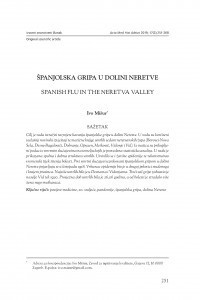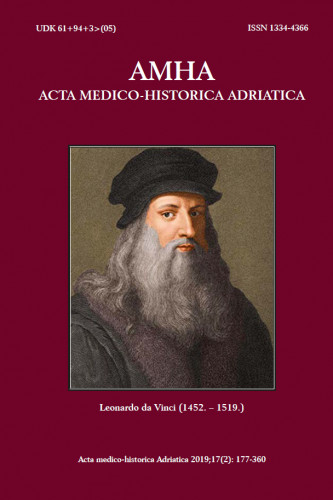Cilj je rada istražiti razmjere haranja španjolske gripe u dolini Neretve. U radu su korišteni tadašnji novinski izvještaji te matične knjige umrlih sedam neretvanskih župa (Borovci-Nova Sela, Desne-Bagalovići, Dobranje, Opuzen, Metković, Vidonje i Vid). Iz matica su prikupljeni podaci o smrtnim slučajevima na temelju kojih je provedena statistička analiza. U radu je prikazana spolna i dobna struktura umrlih. Utvrdilo se i žarište epidemije te rekonstruirao vremenski tijek širenja bolesti. Prvi smrtni slučajevi uzrokovani španjolskom gripom u dolini Neretve pojavljuju se u listopadu 1918. Vrhunac epidemije bio je u drugoj polovici studenoga i krajem prosinca. Najviše umrlih bilo je u Desnama i Vidonjama. Treći val gripe zahvatio je naselje Vid tek 1920. Prosječna dob umrlih bila je 26,06 godina, a od bolesti je stradalo više žena nego muškaraca.; The Spanish flu is a pandemic that was neglected even though it killed more people than World War I. At the end of 1918, newspaper reports are scarce due to war events, press censorships, and burst political events. For decades after the epidemic was over, the Spanish flu was not the subject of scientific research. By analysing the entry from the registers of the six Neretva parishes (Borovci-Nova Selo, Desne-Bagalovići, Dobranje, Opuzen, Metkovic, Vidonje, and Vid), statistical data on the scale of the epidemic were reconstructed as well as the time course of the spread of the disease in the valley. The sex and age structure of the deceased were also analysed. The disease was spreading from Opuzen throughout the valley. The peak of the epidemic was in the second half of November and late December. The villages of the Desne and Vidonje were the most affected. Vid was also captured by the third wave in 1920, which was as deadly as that in 1918. The most affected were women, which fits in Croatian statistics. Comparing the timeline of epidemics in Zagreb and Neretva valley, it is visible that Zagreb was affected earlier by an epidemic. The third wave did not affect Zagreb as much as it did Neretva, especially the village of Vidonje. In these Neretva parishes, people under twenty were mostly affected. This deviates from the general rules and statistics of the Spanish flu, which stated that the most affected population was between the ages twenty and forty. The article deals with data on the Spanish Neretva flu cases, while the number of infections remains unknown.
Sažetak

 Acta medico-historica Adriatica : 17,2(2019) / glavni urednik, editor-in-chief Igor Eterović.
Acta medico-historica Adriatica : 17,2(2019) / glavni urednik, editor-in-chief Igor Eterović.